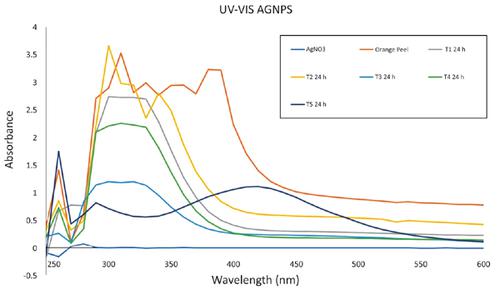Recent Patents on Nanotechnology ( IF 2 ) Pub Date : 2020-08-31 , DOI: 10.2174/1872210514666200414101014 Jose E Quiroz-Hernández 1 , Oxana V Kharissova 2 , Victor E Aguirre-Arzola 1 , Guillermo C G Martinez-Avila 1 , Uziel Castillo-Velazquez 3

|
Aims: To use an agroindustrial waste (orange peels) as a source of polyphenols as a reducing medium for obtaining silver nanoparticles by greener method.
Background: Several techniques have been employed for AgNPs synthesis, nevertheless, most of them involve the use of toxic chemicals in the process. The use of fungi, bacteria, and plant extracts as subtracts for green synthesis is an ecofriendly alternative, although hypothetic, route for AgNPs large scale synthesis. In the case of plant extracts, it is believed that polyphenols are the biomolecules responsible for the reduction and stabilization of the Ag+ ions into AgNPs, being a sustainable and ecological option; polyphenols could be obtained from plant waste and agroindustrial subproducts.
Objective: To develop an efficient, greener, and low-cost method of AgNPs production using natural products.
Methods: The basic principle of silver nanoparticles synthesis is the interaction in a mixture of silver nitrate (source of Ag+ ions) and the orange peel extract (reducing and stabilizing agent) under certain conditions. Five treatments were carried out, evaluating several parameters during AgNPs synthesis such as pH, orange peel extract-silver nitrate ratio, time and conditions of incubation, irradiation of UV light, irradiation of microwave, and temperature.
Result: The synthesis of silver nanoparticles from an agroindustrial waste as the orange peel was successfully carried out and checked by visual evaluation, UV-Vis spectroscopy, and EDS analysis. The particle size was estimated between 42.82 nm to 151.75 nm, having a spherical and ovoid morphology.
Discussion: Through the analysis of several synthesis conditions, it has become possible to establish a suitable treatment to increase antibacterial yield and evaluate morphology and size traits in order to acquire the best conditions for a future industrial scale synthesis.
Conclusion: The orange peel aqueous extract resulted as a great source of polyphenols, allowing the successful synthesis of silver nanoparticles in mild conditions. Thus, obtained AgNPs revealed an increased antibacterial effect and potential against Gram-positive bacteria such as Staphyloccocus aureus.
中文翻译:

橙皮纳米银粒子合成条件及其抗菌作用评价
目的:使用农业工业废物(橙皮)作为多酚的来源,作为还原介质,通过更环保的方法获得银纳米粒子。
背景:多种技术已被用于 AgNPs 的合成,然而,其中大部分都涉及在该过程中使用有毒化学品。使用真菌、细菌和植物提取物作为绿色合成的减法是一种环境友好的替代方案,虽然是假设的,但用于 AgNPs 大规模合成的途径。就植物提取物而言,人们认为多酚是负责将 Ag+ 离子还原和稳定为 AgNPs 的生物分子,是一种可持续和生态的选择;多酚可以从植物废料和农工业副产品中获得。
目的:开发一种使用天然产物生产 AgNPs 的高效、绿色和低成本方法。
方法:纳米银合成的基本原理是硝酸银(Ag+离子源)和橙皮提取物(还原稳定剂)在一定条件下的混合物中的相互作用。进行了五次处理,评估了 AgNPs 合成过程中的几个参数,如 pH 值、橙皮提取物-硝酸银比率、孵育时间和条件、紫外线照射、微波照射和温度。
结果:成功地从作为橘皮的农业工业废物中合成银纳米颗粒,并通过目视评估、紫外-可见光谱和 EDS 分析进行了检查。粒径估计在 42.82 nm 至 151.75 nm 之间,具有球形和卵形形态。
讨论:通过对几种合成条件的分析,可以建立合适的处理方法来提高抗菌产量并评估形态和大小特征,以获得未来工业规模合成的最佳条件。
结论:橙皮水提取物是多酚的重要来源,允许在温和条件下成功合成银纳米颗粒。因此,获得的 AgNPs 显示出对革兰氏阳性细菌(如金黄色葡萄球菌)的抗菌作用和潜力增加。


























 京公网安备 11010802027423号
京公网安备 11010802027423号